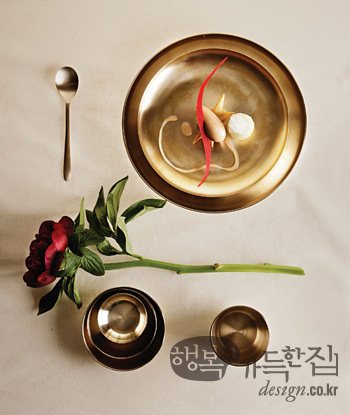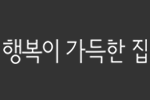 Yugi; brasswareYugi(brassware) is tableware made from brass and was once an important feature of daily life in Korea. Mainly, yugi was used as tableware. However, yugi was also often used outside of the kitchen for items such as candlesticks, inkwells, water containers, incense burner, soban(dining tray-table), washbowl and musical instruments. These yugi items are generally made of yellow brass - an alloy of copper and zinc - but are sometimes produced from alloys of copper and other metals, including bronze - an alloy of copper and tin.
Yugi; brasswareYugi(brassware) is tableware made from brass and was once an important feature of daily life in Korea. Mainly, yugi was used as tableware. However, yugi was also often used outside of the kitchen for items such as candlesticks, inkwells, water containers, incense burner, soban(dining tray-table), washbowl and musical instruments. These yugi items are generally made of yellow brass - an alloy of copper and zinc - but are sometimes produced from alloys of copper and other metals, including bronze - an alloy of copper and tin. Yugi, with its shiny yellow color occupied a central spot in the average household during Chosun Dynasty. During this period, yugi was very common, however, today, it has become valuable. Yugi tableware was seen in almost every household including the royal family, yangban(upper class) as well as seomin(the commoners). All the food on the table, rice, soup, vegetables and meat were placed in yugi tableware. During this period, brassware produced in Anseong was considered to be best in the nation. Custom-made brassware items from the Anseong were renowned for their superb quality, beautiful luster and delicacy. It was around that time that Anseong-machum, which literally means “custom-made in Anseong,” became a common expression used to describe something that fit one’s needs exactly.
The most representative yugi used in everyday life was jegi(dishes used in ancestral memorials), bansanggi(dishes used in for daily tableware). Two typical methods for making yugi were jumul and bangjja technique. Jumul technique requires pouring heated metal into a mold depending on the mixture ratio. The bangjja technique requires precise combination of 78% copper and 22% tin. After the exact mixture of copper and tin are combined, bangjja-yugi requires repeated hammering with heating for formation and requires 11 craftsmen to work in a team until completion. Bangjja-yugi is known for its durability and its worthiness over time. The marks left over from hammering gives bangjja-yugi its charm as a handy-craft. Bangjja-yugi is considered to be the top yugi and is nontoxic, odorless and chemical-free metal. Moreover, it is in demand again due to improvements in the standard of living along with peoples’ focus on health and tradition.
유기는 놋쇠를 이용해 만든 그릇을 말한다. 놋쇠로는 촛대, 향로, 소반, 대야, 악기 등 다양한 생활용품을 만들기도 했다. 놋쇠는 구리(동)를 기본으로 서로 다른 성분의 비철금속(금, 은, 구리, 아연 등 철 이외의 금속의 통칭)을 배합하여 만든 것이다.
은은한 광택의 노란빛을 띠는 유기는 오늘날에는 귀한 그릇이 되었으나 조선시대까지만 해도 일상적인 식생활 도구로 사용되었다. 왕실은 물론 양반집과 서민의 가정에 이르기까지 밥, 국, 나물, 고기 등 다양한 음식을 유기에 담아 상을 차렸다. 수공업이 발달하고 작고 아담한 그릇을 선호했던 안성에서는 유기 주조 기술도 발달해 전국적으로 인기를 얻었는데 여기서 ‘안성맞춤’이란 말이 비롯되었다. 일상생활에 사용한 대표적인 유기로는 제기(제사상에 사용하는 그릇), 반상기(밥상에 사용하는 그릇)가 있다.
유기를 만드는 대표적인 방식에는 주물 기법과 방짜 기법이 있다. 주물 기법은 불에 녹인 쇳물을 일정한 형태의 틀에 부어 만드는 것으로 쇳물의 성분이나 배합 비율에 따라 놋쇠의 종류와 주조 기법이 달라진다. 방짜 기법은 정확하게 78%의 구리와 22%의 주석을 섞어 만드는 우리나라 고유의 금속 기법이다. 방짜 유기는 이와 같은 비율로 배합된 놋쇠를 불에 달궈 망치질을 해가며 형태를 잡아 만드는데, 완성에 이르기까지 11명의 장인이 한 팀을 이뤄 작업을 한다. 방짜 유기는 휘거나 잘 깨지지 않고 비교적 변색이 일어나지 않으며 쓰면 쓸수록 윤기가 나는 것도 장점이다. 또한 성형할 때 망치로 두드린 자국이 매력이기도 하다. 유기 중에서도 최고로 꼽는 방짜 유기는 무독, 무취의 무공해 금속 제품이다. 여기에 은은한 색감과 제품이 맞닿을 때 나는 영롱한 소리에 품위가 더해져 오늘날 그 가치를 높이 평가받고 있다. 한동안 사용 및 관리의 불편함을 이유로 서양 그릇에 밀려났던 유기가 요즘 건강과 전통에 대한 인식이 높아지면서 다시 인기를 얻고 있다.







